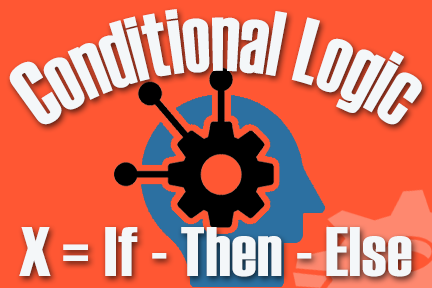 Conditional Logic, simply put, is… if X happens, then what should be the next step? Moreover, what are ALL the next logical steps necessary to ensure compliance, and complete processes without errors?
Conditional Logic, simply put, is… if X happens, then what should be the next step? Moreover, what are ALL the next logical steps necessary to ensure compliance, and complete processes without errors?
i.e., IF such-and-such happens, THEN what’s next, and then what ELSE needs to happen?
Interestingly, building the IF-THEN-ELSE into process control documents is where the advantage resides. In fact, using Conditional Logic will address ALL process variables.
EXAMPLE: A Fire and Water Restoration Tech using the Control Checklist below:
If X = Mold Discovered, the next logical step may be to notify a Mold Mitigation Specialist. The following step may be notifying their Project Manager to conduct a second investigation of the mold problem to determine the need of an outside specialist to mitigate the mold. As you can see, Conditional Logic is an effective way to leave nothing to chance in preforming a task. Consequently, everyone remains on the same page when using standardized processes.
As you can see, Conditional Logic is an effective way to leave nothing to chance in preforming a task. Consequently, everyone remains on the same page when using standardized processes.
For this reason, every key process used in producing products or services should use Quality Assurance checklists with step-by-step PROMPTS (calls to action). Furthermore, the prompts should explain, in easy-to-understand language, the IF, THEN, or ELSE of a process.
In short, when X occurs, what call to action is next.
Additionally, utilizing links like the examples above in red, to further explain a prompt in detail, is a powerful feature for maximizing Conditional Logic documents. For example, links associated with a prompt can automatically notify someone, quickly access contact information in a CRM, or link to a form/document to fill-in, and/or link to, a detail procedure, etc.
The possibilities are endless for organizing any size business.
How do we know?
Since 1994, we’ve implemented Conditional Logic in our own processes, and have been teaching this method to our clients.
Actually, we didn’t call it “conditional logic.” We simply called it, “systematic organization.” That said, implementing intelligent design mapping of processes to run a business is logical; not to mention, intelligent.
More importantly, using this methodology is the road to freedom for owners and managers.
Conditional Logic Prompts – The Trainer in Chief
Again, using Conditional Logic in developing SOP’s leaves nothing to chance. As a result, these standard operational procedures become great training tools for freeing management of constant interruptions from employees seeking information to do their job.
Importantly, considering the right logical actions needed is key.
With this in mind, we’ve provided a link, great help to the reader, to a list of Conditional Logic considerations when building an operation manual.
Often, we hear small business owners say, “We have so many variables in our production and servicing processes, that SOP’s (Standard Operating Procedures) don’t work for our business.
To that I say, hogwash! That excuse is ridiculous.
In the words of W. Edwards Deming, “If you can’t describe what you are doing as a process, you don’t know what you’re doing!”
To be fair, using God-given intelligence, it takes time to design a process by mapping with step-by-step prompts.
However, an owner KNOWS how their business operates, because they deal with it every day!
They also know the variables, the IF’s, THEN’s, or ELSE’s of a process. In other words, the various changes that occur in their operations.
Considering that fact, the owner simply downloads his or her knowledge from their brain into written form, to show step-by-step how each process works.
Excitingly, when an owner has completed mapping their entire business operations, the result is priceless. In fact, they now own a turnkey business. NOT to do this is illogical!
Did I mention? Great systems work!

Recent Comments